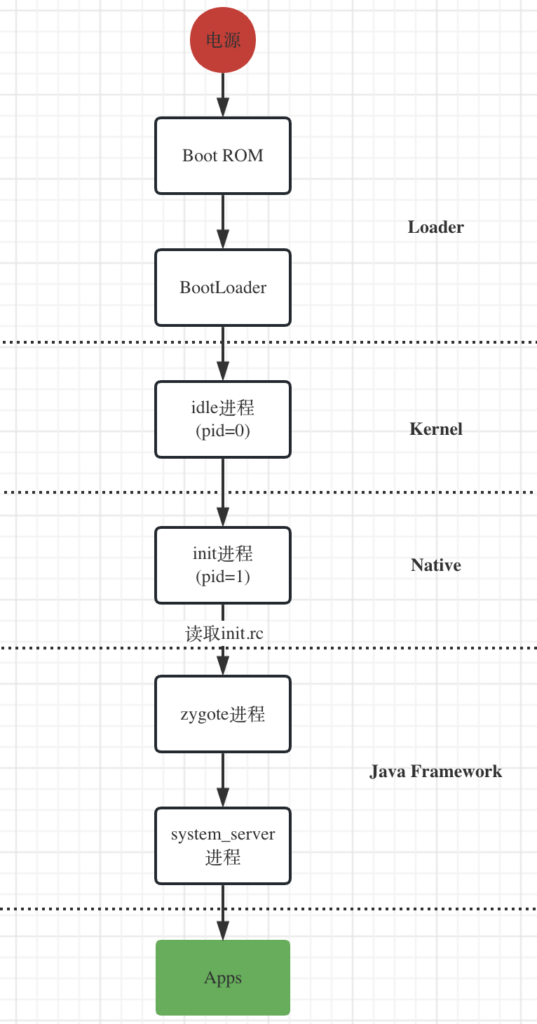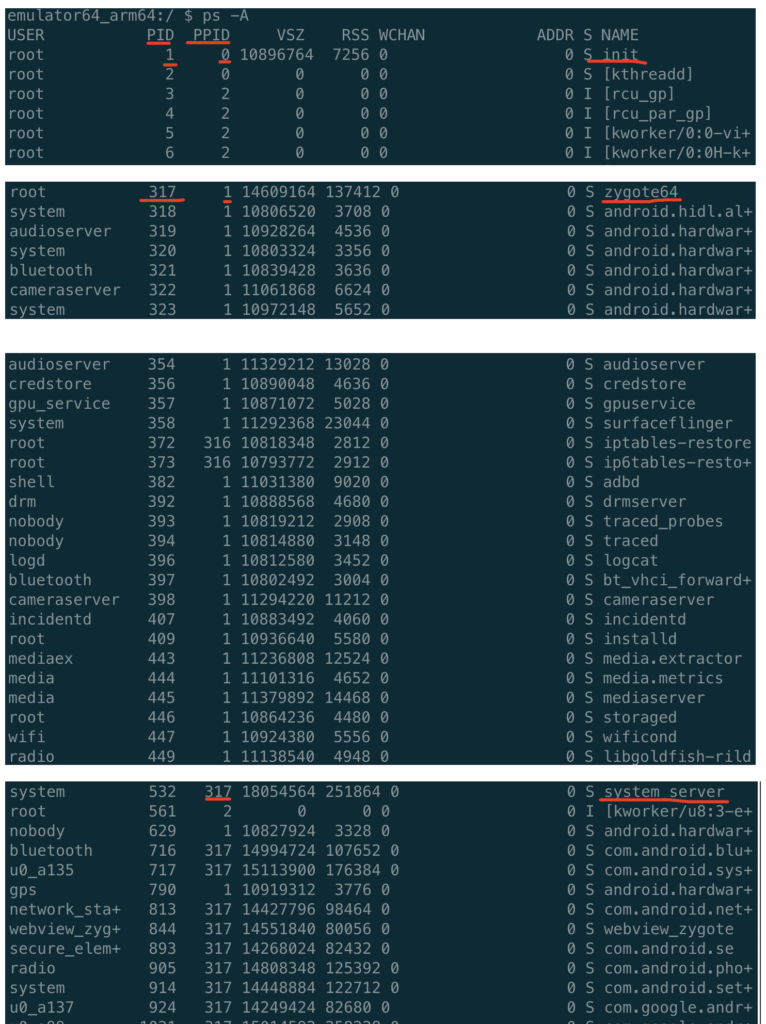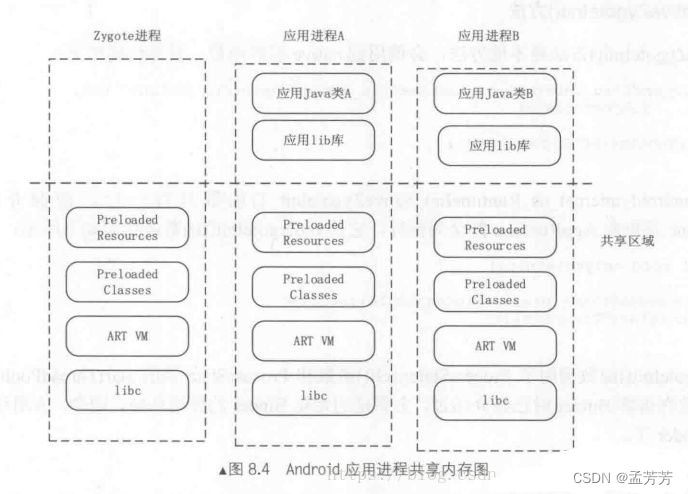

Zygote进程讲解
source link: https://www.longdw.com/zygote/
Go to the source link to view the article. You can view the picture content, updated content and better typesetting reading experience. If the link is broken, please click the button below to view the snapshot at that time.

这几天看了关于Zygote进程相关知识点,感觉对这块又有了新的认识了,接下来结合自己的理解将相关知识点记录下来,一来是好记性不如烂笔头,记录下来有助于后期查阅,二来是想通过写博客的方式加深对知识点的理解,三来是想将知识共享出来给需要的人。
我们学习一个知识点首先要问下自己问啥要学习这个?我学习Zygote相关知识点是因为很久之前就听说过它是用来孵化进程的,但是不知道它的工作原理是什么。因为万变不离其宗,只有懂得了内在原理才能更好的看清事物的本质。好了废话不多说了,开始进入正题。
Zygote无论你之前有没有听说过,我希望通过本篇博客的学习,你至少能够知道:
1)它是做什么的?
2)它跟init进程的关系是什么?
3)它跟我们app进程有什么关系?
4)它的工作原理是什么?
1.Zygote的作用
Zygote顾名思义就是孵化,它是用来孵化和管理Android系统中所有应用进程,而它自己也是一个进程。Zygote在Android系统启动时就会被启动,它会先预加载一些常用的类和资源,以便后续的应用程序进程能够快速启动。当一个应用程序需要启动时,Zygote会fork一个新进程,并把一些已经加载好的类和资源共享给这个新进程,以提高应用程序的启动速度。
看到上面这段解释我们脑海中可能会出现很多问号,Zygote是怎么启动的?它是如何预加载类和资源的,为什么要预加载?它是怎么fork进程的?等等。我们先不用考虑,等放到后面讲原理的时候再讲解。
2.Android系统启动流程

电源键按下后首先Boot ROM将引导程序BootLoader程序加载进内存中,接着BootLoader引导启动linux系统,系统起来后就开始启动0号进程idle,然后idle启动1号进程init,接着init进程会读取
init.rc文件,这个文件实际上就是linux脚本,里面定义了各种需要启动的服务。Zygote进程就是init进程启动的进程之一,Zygote第一个fork出来的进程就是system_server进程,我们熟悉的AMS、PMS、WMS等Android框架层服务都是这个system_server进程启动的。在下一节的原理部分会详细介绍。

以上是执行
adb shell后再执行ps -A看到的进程详情,PPID那一列是父进程号,PID列是当前进程号。可以看到audioservice、logcat、installd等服务都是由init进程启动的,这些进程是杀不掉的,当我们用
kill -9 xxx来杀掉进程后,再次ps -A后会发现刚被杀掉的进程又会起来。init进程的主要作用就是 :1)启动系统关键服务。2)守护关键服务。
然后再看下关键进程zygote64,它的进程号是317(这个进程号是随机的),所有PPID是317的进程都是它来负责启动的,比如system_server进程。
看到这里有人会问:说了这么多你还没告诉我zygote到底有啥用?你上面说的system_server进程是它fork出来的,system_server又是干啥的?它的作用就是只启动system_server进程吗?别急,接下来希望通过下面的讲解,慢慢揭开zygote神秘的面纱。
3.原理讲解
(1)先看下system/core/rootdir/init.rc文件
import /init.environ.rc
import /system/etc/init/hw/init.usb.rc
import /init.${ro.hardware}.rc
import /vendor/etc/init/hw/init.${ro.hardware}.rc
import /system/etc/init/hw/init.usb.configfs.rc
import /system/etc/init/hw/init.${ro.zygote}.rc
......
引入了其他rc文件,再看下system/core/rootdir/init.zygote64.rc文件
service zygote /system/bin/app_process64 -Xzygote /system/bin --zygote --start-system-server
class main
priority -20
user root
可以看到rc文件实际上是linux脚本文件,最终会通过service命令来启动zygote服务。那app_process又是什么?
zygote是通过app_process启动,看下frameworks/base/cmds/app_process/app_main.cpp
/*
* Main entry of app process.
*
* Starts the interpreted runtime, then starts up the application.
*
*/
int main(int argc, char* const argv[])
{
if (!LOG_NDEBUG) {
String8 argv_String;
for (int i = 0; i < argc; ++i) {
argv_String.append("\"");
argv_String.append(argv[i]);
argv_String.append("\" ");
}
ALOGV("app_process main with argv: %s", argv_String.string());
}
......//省略
AppRuntime runtime(argv[0], computeArgBlockSize(argc, argv));
// Parse runtime arguments. Stop at first unrecognized option.
bool zygote = false;
bool startSystemServer = false;
bool application = false;
String8 niceName;
String8 className;
++i; // Skip unused "parent dir" argument.
while (i < argc) {
const char* arg = argv[i++];
if (strcmp(arg, "--zygote") == 0) {
zygote = true;
niceName = ZYGOTE_NICE_NAME;
} else if (strcmp(arg, "--start-system-server") == 0) {
startSystemServer = true;
} else if (strcmp(arg, "--application") == 0) {
application = true;
} else if (strncmp(arg, "--nice-name=", 12) == 0) {
niceName.setTo(arg + 12);
} else if (strncmp(arg, "--", 2) != 0) {
className.setTo(arg);
break;
} else {
--i;
break;
}
}
.....//省略
if (!niceName.isEmpty()) {
runtime.setArgv0(niceName.string(), true /* setProcName */);
}
if (zygote) {
runtime.start("com.android.internal.os.ZygoteInit", args, zygote);
} else if (className) {
runtime.start("com.android.internal.os.RuntimeInit", args, zygote);
} else {
fprintf(stderr, "Error: no class name or --zygote supplied.\n");
app_usage();
LOG_ALWAYS_FATAL("app_process: no class name or --zygote supplied.");
}
}
service zygote /system/bin/app_process64 -Xzygote /system/bin --zygote --start-system-server 这段命令启动的服务最终会传入main函数中的argv参数,然后解析参数,具体代码从上面代码30行开始。
runtime.setArgv0(niceName.string(), true /* setProcName */);实际上是给app_process重新设置了另外一个名字
zygote64。
AppRuntime runtime(argv[0], computeArgBlockSize(argc, argv));启动虚拟机。
runtime.start("com.android.internal.os.ZygoteInit", args, zygote);在虚拟机中运行ZygoteInit,ZygoteInit是java写的,即这一步Zygote就从native世界进入到了Java世界。
Zygote的java世界入口就是ZygoteInit类的main方法,看下frameworks/base/core/java/com/android/internal/os/ZygoteInit.java
public static void main(String[] argv) {
ZygoteServer zygoteServer = null;
...... //省略
Runnable caller;
try {
...... //省略
boolean startSystemServer = false;
String zygoteSocketName = "zygote";
String abiList = null;
boolean enableLazyPreload = false;
for (int i = 1; i < argv.length; i++) {
if ("start-system-server".equals(argv[i])) {
startSystemServer = true;
} else if ("--enable-lazy-preload".equals(argv[i])) {
enableLazyPreload = true;
} else if (argv[i].startsWith(ABI_LIST_ARG)) {
abiList = argv[i].substring(ABI_LIST_ARG.length());
} else if (argv[i].startsWith(SOCKET_NAME_ARG)) {
zygoteSocketName = argv[i].substring(SOCKET_NAME_ARG.length());
} else {
throw new RuntimeException("Unknown command line argument: " + argv[i]);
}
}
...... //省略
// In some configurations, we avoid preloading resources and classes eagerly.
// In such cases, we will preload things prior to our first fork.
if (!enableLazyPreload) {
......
preload(bootTimingsTraceLog);
......
}
......
zygoteServer = new ZygoteServer(isPrimaryZygote);
if (startSystemServer) {
Runnable r = forkSystemServer(abiList, zygoteSocketName, zygoteServer);
// {@code r == null} in the parent (zygote) process, and {@code r != null} in the
// child (system_server) process.
if (r != null) {
r.run();
return;
}
}
Log.i(TAG, "Accepting command socket connections");
// The select loop returns early in the child process after a fork and
// loops forever in the zygote.
caller = zygoteServer.runSelectLoop(abiList);
} catch (Throwable ex) {
Log.e(TAG, "System zygote died with fatal exception", ex);
throw ex;
} finally {
if (zygoteServer != null) {
zygoteServer.closeServerSocket();
}
}
// We're in the child process and have exited the select loop. Proceed to execute the
// command.
if (caller != null) {
caller.run();
}
}
ZygoteInit的main()方法是Android启动中的第一个Java进程的主方法。它主要完成几件事情,首先看下preload:
private static final String PRELOADED_CLASSES = "/system/etc/preloaded-classes";
static void preload(TimingsTraceLog bootTimingsTraceLog) {
Log.d(TAG, "begin preload");
bootTimingsTraceLog.traceBegin("BeginPreload");
beginPreload();
bootTimingsTraceLog.traceEnd(); // BeginPreload
bootTimingsTraceLog.traceBegin("PreloadClasses");
preloadClasses();
bootTimingsTraceLog.traceEnd(); // PreloadClasses
bootTimingsTraceLog.traceBegin("CacheNonBootClasspathClassLoaders");
cacheNonBootClasspathClassLoaders();
bootTimingsTraceLog.traceEnd(); // CacheNonBootClasspathClassLoaders
bootTimingsTraceLog.traceBegin("PreloadResources");
preloadResources();
bootTimingsTraceLog.traceEnd(); // PreloadResources
Trace.traceBegin(Trace.TRACE_TAG_DALVIK, "PreloadAppProcessHALs");
nativePreloadAppProcessHALs();
Trace.traceEnd(Trace.TRACE_TAG_DALVIK);
Trace.traceBegin(Trace.TRACE_TAG_DALVIK, "PreloadGraphicsDriver");
maybePreloadGraphicsDriver();
Trace.traceEnd(Trace.TRACE_TAG_DALVIK);
preloadSharedLibraries();
preloadTextResources();
// Ask the WebViewFactory to do any initialization that must run in the zygote process,
// for memory sharing purposes.
WebViewFactory.prepareWebViewInZygote();
endPreload();
warmUpJcaProviders();
Log.d(TAG, "end preload");
sPreloadComplete = true;
}
private static void preloadClasses() {
final VMRuntime runtime = VMRuntime.getRuntime();
InputStream is;
try {
is = new FileInputStream(PRELOADED_CLASSES);
} catch (FileNotFoundException e) {
Log.e(TAG, "Couldn't find " + PRELOADED_CLASSES + ".");
return;
}
......
}
该方法预加载了虚拟机运行时所需的各类资源,比如上面的preloadClasses,就预加载了各种系统类。因为我们每个android应用程序都会用到系统资源,预加载后所有由zygote fork出来的应用进程都能共用一块内存。借用网上的图:

通过上图可以很容易理解在Zygote进程预加载系统资源后,然后通过它孵化出其他的虚拟机进程,进而共享虚拟机内存和框架层资源,这样大幅度提高应用程序的启动和运行速度。
zygoteServer = new ZygoteServer(isPrimaryZygote);创建一个socket服务端,用于等待AMS请求Zygote创建新的应用程序进程。
forkSystemServer启动system_server服务。
最后借用一幅图来总结下整个流程:

通过以上介绍,再回过头看看第1节介绍的zygote的作用,相信大家应该有稍微深刻点的认识了。总结下,init进程属于linux进程,init进程启动zygote进程,它属于java进程,zygote负责创建android应用进程和预加载应用程序启动必要的资源,其中比较重要的systemserver进程负责启动android中重要的服务,不如AMS、PMS、WMS等等。下一章中将介绍PMS相关知识点。
这篇文章写的也很不错:https://blog.csdn.net/zenmela2011/article/details/125330521
Recommend
About Joyk
Aggregate valuable and interesting links.
Joyk means Joy of geeK